Clearwater Area State Parks
Authentic Florida
Fort De Soto Park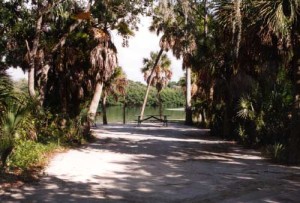
Fort De Soto Park consists of a string of five small islands off the coast of St. Petersburg. The fort was built during the Spanish-American War in the late 1890’s and is open to the public. The last brickwork fort constructed in the United States, the fort never saw action and was donated to the county for use as a park in the 1940s. The beaches in the park are enormous and completely private. North Beach faces the Gulf of Mexico, and East Beach offers a stunning view of the St. Petersburg Skyway. Picnic shelters are located at both the North Beach and East Beach areas.
The campgrounds at Fort De Soto Park occupy all of St. Christopher Key. Bayside campsites enjoy a picture-perfect setting of tall, tropical plants and shrubs, offering cooling shade and a perfectly framed window on the bay.
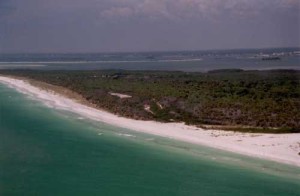 Caladesi Island State Park
Caladesi Island State Park
One of the few remaining undeveloped barrier islands in the state, most of coastal Florida at one time resembled Caladesi Island. Pine and palm forests lead to rolling dunes covered with indigenous grasses, which guides you to a long stretch of white sandy beach. A relative newcomer to Florida, the island was created when a savage 1921 hurricane separated it from what was then Hog Island. The actual origin of the island’s name is uncertain, though it has appeared on maps since the 1930s.
Accessible only by ferry from Clearwater and nearby Honeymoon Island State Park, visitors can fish, picnic, boat, shell or meander the pine and oak forests. A wide variety of coastal birds call this park home. Picnic tables and concessions are located near the beach, and a 99-slip marina is available for those who arrive by personal boat. Overnight dockage is permitted with registration.
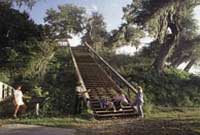 Crystal River Archaeological State Park
Crystal River Archaeological State Park
One of the most important pre-Columbian discoveries in Florida, Crystal River State Archaeological Site consists of six ceremonial and burial mounds. These Indian mounds mark the site of 1600 years of human habitation, and stand in memorial to a vanished civilization. A museum holds a number of artifacts excavated on site, with an adjacent small gift shop.
Interpretive trails lead visitors past the six mound sites, which include Temple, Burial and Midden Area mounds. Two large limestone boulders seen along the trail may have served as ceremonial markers. The Temple mound also offers a beautiful view of Crystal River from an observation deck.
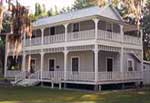 Gamble Plantation
Gamble Plantation
Most do not envision Florida relative to the War Between the States. However, many plantations were established and prospered here. The sparsely settled peninsula created such difficulties with obtaining supplies and shipping product that few settlers were willing to take the risk. These challenges did not deter one Major Robert Gamble.
In 1844 Major Gamble, a veteran of the Second Seminole War, decided to settle in the area of the Manatee River and establish a sugar plantation. Gamble purchased 3,500 fertile acres northeast of what is now Bradenton and his plantation soon successfully produced sugar cane, molasses, citrus, grapes and olives.
The mansion became the showplace of the area. Designed with hot Florida summers in mind, the red brick and tabby walls of the Greek Revival home are nearly two feet thick. Strategically placed windows and a breezeway allow cross breezes, with upper and lower verandas that extended around three sides of the structure. Gamble also developed an elaborate water catchment system that survives to this day.
During the Civil War, Union soldiers destroyed the sugar mill. As the Confederacy collapsed, Judah P. Benjamin, the Confederacy Secretary of State, took refuge at the mansion to avoid capture by Union soldiers.
Following the war, the mansion was sold to the Patten family. A smaller home was added to the property for Major Patten’s son. When the Patten’s fell on hard times, the property was acquired by a fertilizer company for back taxes. The Daughters of the Confederacy saved the property in 1925, and restored the home to its rightful grandeur.
Today, visitors to Gamble Plantation State Historic Site can tour the beautiful mansion and grounds. The Patten House, an excellent example of a pioneer Florida farmhouse, is also open to the public. A visitor center features exhibits from Florida’s Antebellum and Pioneer periods, with a picnic area on beautifully landscaped grounds.
Hillsborough River State Park
Offering a great canoeing location, Hillsborough River State Park is a jewel in Florida’s State Park System. A huge man-made and spring-fed swimming pool draws crowds of swimmers on hot summer days. Boasting eight miles of hiking trails, this park appeals to the avid hiker and nature enthusiast.
Canoeing the Hillsborough River offers everything from rapids to tranquil paddling through pristine natural surroundings. Canoe rentals are available in the park. Hiking trails wander the hammocks of live oak, sabal palm and hickory.
Vistors can explore Fort Foster, a recreated 1830s fort located across the street from the park entrance. Volunteers clad in period dress re-enact the lives of the soldiers stationed at the fort, whose role was to protect a military road during the Indian wars.
Hillsborough River State Park features inviting camping areas, with 106 sites for tent and RV’s, of which 84 offer electricity. Each of the sites provides picnic tables and grills. The campground is equipped with restrooms, a snack bar, laundry facilities and hot showers.
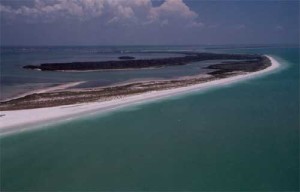 Honeymoon Island State Park
Honeymoon Island State Park
Honeymoon Island was once an unnamed barrier island along Florida’s Southwest Coast. At various times inhabited by Tocobaga Indians, Spanish explorers, pirates, and fishermen, the island was initially shown on maps as Sand Island. By 1880, the island became known as Hog Island, which it remained until it was promoted as a resort location for honeymooners in the early 1940s.
Today’s visitors can enjoy the beautiful white sand beach that stretches the length of the island and includes a pet beach. Visitors enjoy swimming, shelling, fishing and several hiking several trails.
 " alt="" />
" alt="" />